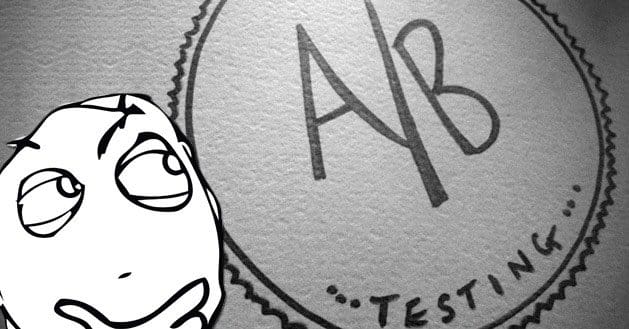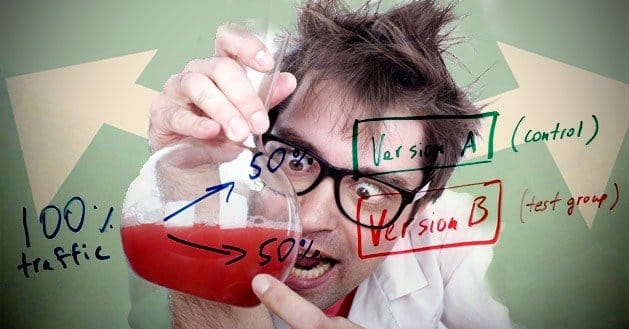 Written by ContentPowered.com
Written by ContentPowered.com
Marketing metrics offer the possibility of more return on investment (ROI). When marketing specialists use Facebook analytics to test online advertising performance, metric reporting may lead to a more profitable retargeting strategy. Statistical reliability afforded in Facebook Exchange (FBX) tools like Status Updates, enable the collection of valuable data, as well as trend forecast of ad performance.
The best benchmark metrics for marketing reporting include the results to A/B Split Tests. A/B testing is a strategy used by marketing analysts to maximize ROI. In a standard A/B test, the process to testing reflects laboratory testing, where a population sample of is split into a Control A, and Treatment B. The latter, B is the test sample, modified by new variables. The former, A, is unmodified, and provides the point of comparison on an A/B distribution axis on result frequencies.
In a controlled test, a control advertisement should be run for a specified period to time measure ratio of clicks and conversion with demographic and other variables. Volume response with high conversion, would mean that many people liked the ad, and that it was powerful enough to promote sign up or purchase once arriving at the landing page. Outcomes to an A/B test signify median frequency of response. This is exceptionally useful for determining the strength of an ad’s content and placement in respect to conversion.
What are your goals?
If the goal on an online marketing campaign is to generate the most traffic per ad unit to an advertiser’s website for sign up or purchase, performance testing is a critical measure for ensuring ROI. Multivariate analysis allows for testing of co-efficient dyads (two variables) in comparison, or even triangulation (three variables) to determine the driver or outcome to a particular ad spot’s performance.
A great method of testing landing pages, marketing emails, websites, as well as online advertising, A/B testing is a reliable econometric for reporting on the ROI in a marketing strategy. A/B testing can also be applied to feasibility testing of an online advertising campaign prior to launch. An online A/B Test Calculator can be used to compute preliminary results. Facebook Status Updates provides data for use in the test with continuous reporting on ad performance.
Confidence levels should be 95% or better. If the result deviates below the 95% level, the campaign should be reassessed. One reason that statistical confidence is statistically insignificant, is that the effect size is too small due to low visitor response. Alternately, the result may reflect an unreliable comparison of two dependent variables: conversions or click-through-rates. Whatever the circumstance to poor performance, chances are that the campaign will not go viral unless campaign values are changed. Facebook FBX supports easy retargeting once ad content, image or call-to-action is tested.
Preparation for an A/B test requires a few tools: Facebook Page, Facebook Ads account, and Access to Facebook’s Power Editor. Once an Ads account is established, use a Chrome browser and add the Facebook Power Editor extension. Select two posts for the A/B test before commencement of the testing process. The two posts fulfill the requirement for Control sample and Treatment sample.
Setting up an A/B Test in Facebook
- Step 1: Login the Facebook Ads account and click on Power Editor. Download existing campaigns if available.
- Step 2: In Power Editor click ‘Campaigns’ and ‘Create Campaign’ to name the campaign.
- Step 3: Next click ‘Ads’ and ‘Create Ad’ to name an ad.
- Step 4: Under the ad type select “For a Facebook Page Using a Post” to select the Facebook page as Destination.
- Step 5: Now click ‘Create New Unpublished Post’. The pop-up window guides the selection of a post type (link, photo, status, video). Design a post.
- Step 6: Under Audience click ‘Connections’ select ‘Target Users Who are Connected To’ the page.
- Step 7: Click ‘Create ad’ and repeat the ad creation process.
- Step 8: Press ‘Upload’ to upload the posts to the Facebook ad account.
Conducting the ‘5’ Step A/B Test on Facebook FBX Ads
Use Facebook Status Updates to collect data on the FBX test campaign. Once the ads have run for two days, there should be adequate metric reporting to run the test. Use outcomes to News Feed ads in comparison with those observed in the right-sidebar to test performance of differentiated placement of similar content in the new campaign.
1. A/B Image Testing
Images offer first impression. One of the most aspects of a Facebook Ad, image engagement leads to conversion. Test FBX ads placed on the News Feed for highest probability of performance.
2. A/B Title Testing
Second to the ad image, title probably the most critical factor for capturing audiences. The Control ad should be titled with the logo or other marker of recognized brand identity. The Treatment ad should include an added value proposition – something outside of the ordinary for testing new content.
3. A/B Details Testing
Small changes can produce big results. With A/B testing it is possible to evaluate discretionary changes in color, style, font, or other subtle nuance. Graphic design stands to radically alter performance. Retargeting responses to details testing may be conducted with standard graphics from Microsoft Paint or other graphics application. The click-through-rate is the strongest indicator. Use it to analyze ad details performance once changed.
4. A/B Ad Body Copy Testing
The message behind the conversion, body copy is important to capturing and retaining interest. Fresh copy can induce wonderful results. If there is a significant difference between two ads running with the same placement and other factors have been eliminated in causal analysis, then the next step is to revise copy or sink.
5. A/B Target Audience Testing
Channel marketing campaigns require target audience testing. Important for large and small businesses, this set of independent variables will inevitably impact the outcome of both the Control and Treatment ads. Use Facebook Connections, Locations other demographic tool to enhance the targeting strategy of an online advertising campaign. If A/B outcomes indicate that clicks are aggregating in a certain city or region, retargeting may be in order. Increase Facebook Ad conversions with minimal effort with demographic tools.
Summating the Results
Remember the substance behind the dataset is conversion. When conducting an A/B test with Facebook Status Updates metric results are based on the formula: Click-through-Rate divided by Views. When calculating the Conversion Rate, similar computation is achieved in: Conversions divided by Clicks. Finally, interpretation of Interpretation of A/B Test’s Performance should be assessed for statistical significance. Statistically significant outcomes will reflect a 95% confidence level at minimum. Tests not resulting 95% or higher should be evaluated for retargeting.
Unlike other marketing metric analysis, a true A/B test enables flexible analysis of a campaign. While some statistical significant may be followed by image or copy changes, a good grasp of multivariate regression modeling might also lead to changes across the entire spectrum of campaign values. Test for ad values as well as targeting strategies by conducting triangulation analysis. For the most comprehensive and accurate online marketing campaign, combine Facebook Exchange ad metrics with A/B testing for optimum results.



It would be great if Facebook Ads could release a feature like this, I’d love to use it!!!